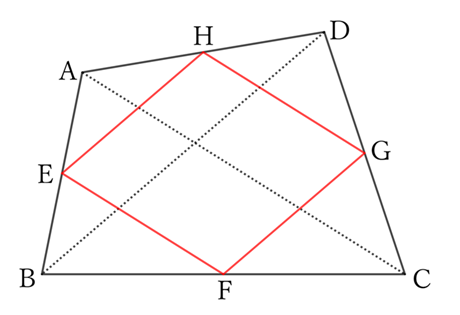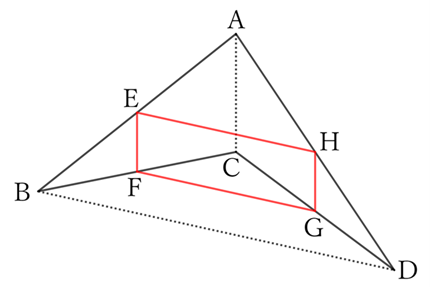$\downarrow$ $\downarrow$ $\downarrow$ $\downarrow$ $\downarrow$
$$ $$Solution


$△ADB$ and $△AHE$ share $∠A$,
$$BA∶EA=AD∶AH=2∶1,$$
$$∴ \ △ADB∼△AHE,$$
$$∴ \ ∠DBA=∠HEA,$$
$$∴ \ DB∥HE, \qquad [1]$$
$$and \qquad DB∶HE=2:1,$$
$$∴ \ HE=\frac{1}{2} DB. \qquad [2]$$
$△BCD$ and $△FCG$ share $∠C$,
$$BC∶FC=CD∶CG=2∶1,$$
$$∴ \ △BCD∼△FCG,$$
$$∴ ∠CDB=∠CGF,$$
$$∴ \ DB∥GF, \qquad [3]$$
$$and \qquad DB∶GF=2∶1,$$
$$∴ \ GF=\frac{1}{2} DB. \qquad [4]$$
From $[1]$ and $[3]$,
$$HE∥GF. \qquad [5]$$
$△ABC$ and $△EBF$ shares $∠B$,
$$AB∶EB=BC∶BF=2∶1,$$
$$∴ \ △ABC∼△EBF,$$
$$∴ \ ∠BCA=∠BFE,$$
$$∴ \ AC∥EF, \qquad [6]$$
$$and \qquad AC:EF=2:1,$$
$$∴ \ EF=\frac{1}{2} AC. \qquad [7]$$
$△ACD$ and $△HGD$ share $∠D$,
$$CD∶GD=DA∶DH=2∶1,$$
$$∴ \ △ACD∼△HGD,$$
$$∴ \ ∠DAC=∠DHG,$$
$$∴ \ AC∥HG, \qquad [8]$$
$$and \qquad AC:HG=2:1,$$
$$∴ \ HG=\frac{1}{2} AC. \qquad [9]$$
From $[6]$ and $[8]$,
$$EF∥HG. \qquad [10]$$
From $[5]$ and $[10]$, the quadrilateral $EFGH$ is a parallelogram.
Also, from $[2], \ [4], \ [7]$ and $[9]$,
$$EF+FG+HG+HE=\frac{1}{2} AC+\frac{1}{2} DB+\frac{1}{2} AC+\frac{1}{2} DB =AC+DB.$$
In other words, the perimeter of the parallelogram is equal to the sum of the two diagonals of the original quadrilateral.
Reference Teiichiro Sasabe (1976) The Encyclopedia of Geometry (2nd edition), Seikyo-Shinsha, pp.42-43.